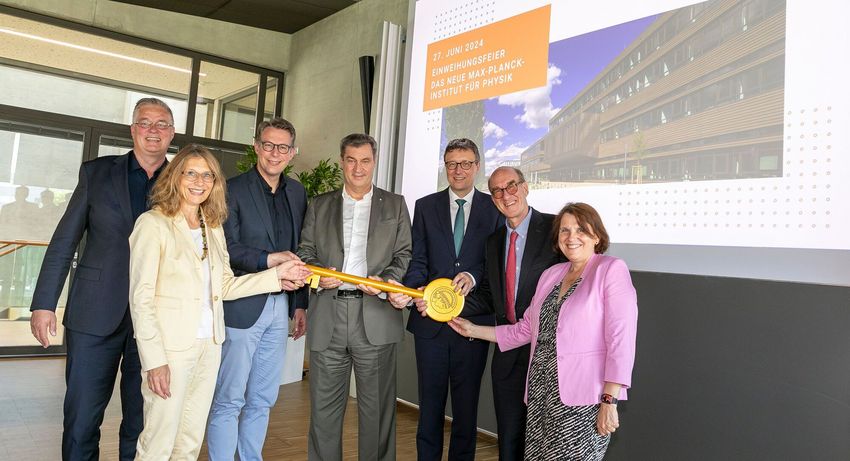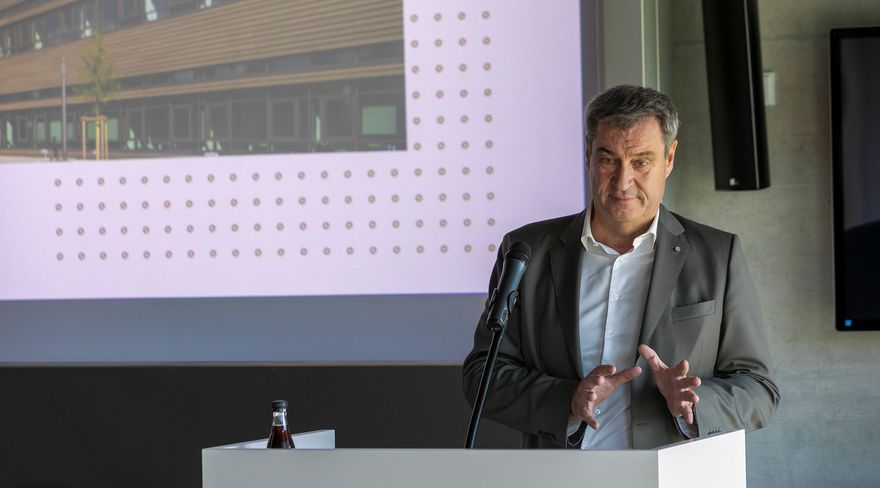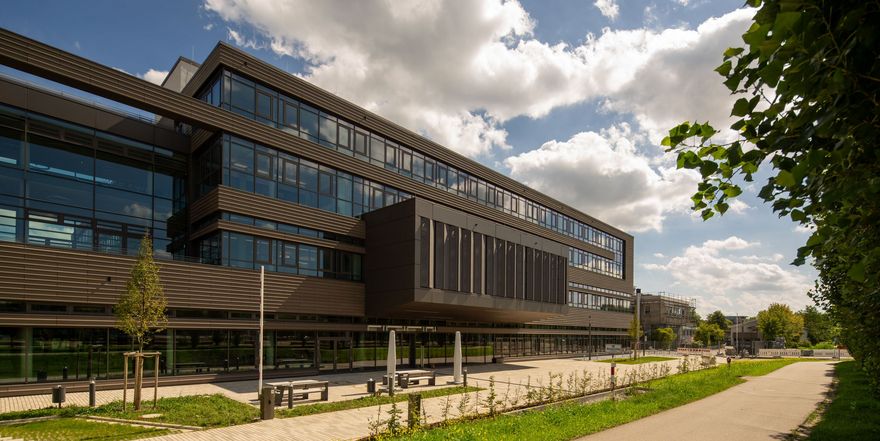Both politicians conveyed their congratulations on the successful completion of the building. Minister President Markus Söder talked about the importance and further strengthening of Bavaria as a science location. Minister President Dr. Markus Söder: "Research into the formation of the earth, dark matter and space projects is being conducted here in state-of-the-art laboratories. All of this is intended to explain our world and make it better. The Max Planck Society is a forge for Nobel Prize winners and is one of the world's best institutions for fundamental research. We in Bavaria firmly believe in the future: with the High-Tech Agenda alone, we are investing 5.5 billion euros in science and technology. This is the largest research program in Germany and attracts scientists from all over the world. We are creating 13,000 new study places, 1,000 professorships and 100 chairs for artificial intelligence alone. Live long and prosper!"
Press releases

Ceremonial handover of the key: (from left) Dr. Dietmar Gruchmann, Mayor of the City of Garching, Dr. Simone Schwanitz, Secretary General of the Max Planck Society, Markus Blume, Bavarian Minister of Science, Dr. Markus Söder, Bavarian Minister President, Prof. Dr. Patrick Cramer, President of the Max Planck Society; Prof. Dr. Dieter Lüst, Managing Director of the Max Planck Institute for Physics; Prof. Dr. Claudia Felser, Vice President of the Max Planck Society (Photo: Axel Griesch/MPP)
Ceremonial inauguration of the new MPP building - an important step towards an innovative future

Science Minister Markus Blume said: "The inauguration of the new Max Planck Institute for Physics is a great celebration of progress: the Max Planck Society is the best that science has to offer. It is the German forge of Nobel Prize winners and the central institution for progress in our country. And Garching is the perfect location for the new institute. Here, Planck's outstanding basic research meets users from industry and our Bavarian universities of excellence - a unique innovation ecosystem. In Bavaria we know: From 'nothing' comes 'nothing' and a lot helps a lot. With our High-Tech Agenda, we are therefore investing 5.5 billion euros in bright minds and innovation. We want to develop the key technologies of the future ourselves, which will bring prosperity and security."
In his speech, Patrick Cramer began by talking about the unique history of the institute and emphasized the central role it has played in opening up new fields of research, founding new Max Planck Institutes and implementing innovations. "The new building stands for the future of the Institute and its research. This is where the next generation of researchers can pursue their ideas. We can only guess what influence the knowledge gained will have on our understanding of the world and on the further development of science and society."
A new home on a vibrant research campus
In his welcome speech, Prof. Dieter Lüst, who as Managing Director of the MPP oversaw the construction phase of the project, thanked the Free State of Bavaria and the Max Planck Society for their financial support and the successful realization of the new building at the heart of the vibrant Garching research campus. He emphasized the positive impact of the proximity to the other research institutions with a focus on physics - be it the LMU, TUM or the neighboring four Max Planck Institutes (MPI) for Astrophysics, Extraterrestrial Physics, Plasma Physics and Quantum Optics.
"The exchange with scientists working on similar or related topics has intensified considerably," says Dieter Lüst. "This contributes significantly to deepening existing collaborations and initiating new research projects, for example at CERN in Geneva, the search for new particles such as dark matter, research into black holes, in the field of laser physics or the development of new accelerators using high-energy plasma fields."
The Institute was founded by Albert Einstein in 1917
With the move to the new building at the Garching Research Center, the MPP said farewell to its location at the Englischer Garten in Munich, where it had been based for 65 years. This closes the circle in a rich history of research: the new domicile is located in the immediate vicinity of three other Max Planck Institutes that were spun off from the MPP in the last century - the MPIs for Astrophysics, Plasma Physics and Extraterrestrial Physics.
The institute, founded by Albert Einstein in Berlin in 1917, initially moved to Göttingen after the Second World War. Under its long-time director Werner Heisenberg, the MPI for Physics moved to Munich in 1958, more precisely to the Schwabing/Freimann district. The MPP will now continue its research activities at its new location at the Garching Research Center.

In addition to the strategic advantages, practical considerations also played a role in the decision to relocate. The old building on Föhringer Ring in Schwabing/Freimann had reached its limits in terms of space and modernization requirements.
Common spaces for vibrant exchange
The new building was designed by the Munich-based architectural firm Brechensbauer Weinhart + Partner Architekten. The building is divided into two units, which enclose the façade like a brace. The larger part houses the state-of-the-art laboratory wing and the offices, while the workshop building for various departments is located next to it and can be accessed via several interior and exterior entrances.
The spacious, light-flooded building offers the working groups plenty of space for informal meetings and the discussions that are so important for research. Numerous common rooms have been set up for this purpose, including 11 seminar rooms of different sizes, several tea kitchens and seating areas as well as the extremely popular Café Heisenberg in the central entrance hall.
The Max Planck Society is the client of this major project. The new building was financed by the Science Conference, in which representatives of the federal and state governments decide on research funding issues and science policy strategies. The costs for the new building amounted to 72.8 million euros.